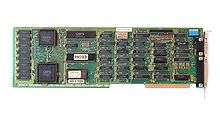Controller (computing)
In computing and especially in computer hardware, a controller is a chip, an expansion card, or a stand-alone device that interfaces with a peripheral device. This may be a link between two parts of a computer (for example a memory controller that manages access to memory for the computer) or a controller on an external device that manages the operation of (and connection with) that device.
The term is sometimes used in the opposite sense to refer to a device by which the user controls the operation of the computer, as in game controller.
In desktop computers the controller may be a plug in board, a single integrated circuit on the motherboard, or an external device. In mainframes the controller is usually either a separate device attached to a channel or integrated into the peripheral.
Controller boards

Early desktop computers such as the IMSAI 8080 used expansion boards (or expansion cards) for all controllers, each handling a specific type of device. Examples of expansion board controllers are:
- Graphics controller or video display controller
- SCSI controller, more properly called SCSI host bus adapter
- Network interface controller (NIC)
- Parallel port controller
Controller chips
As chip densities improved controllers were implemented as single chips and often located on the motherboard. Examples are:
- Keyboard controller
- Programmable Interrupt Controller
- Northbridge (computing) – Intel memory controller chip
- Southbridge (computing) – Intel I/O controller chip
- Universal asynchronous receiver/transmitter (UART) communications controller chip
- Memory controller, logic which manages the flow of data in a computer system
- Peripheral DMA controller
- Floppy disk controller
Further integration enabled development of Super I/O chips — single chips that could control a variety of devices such as floppy disks, parallel ports, serial ports, keyboard, and mouse.
External controllers

- Disk controller, often integrated into modern disk drives.
- Disk array controller, also known as RAID controller, a type of storage controller
- Flash controller, or SSD controller, manages flash memory.
- Terminal Access Controller
Mainframe controllers

In IBM terminology a controller is "a device that decodes the [channel] command and effects the operation of the device."[2]:p.5-1
In most mainframe systems a device-independent channel usually attaches to the CPU and to a controller or control unit which implements device-dependent logic for attaching specific devices. The functions performed by the control unit are similar to the functions performed by a device driver program on smaller systems. Some devices have integrated control units, which are logically discrete but are included with the device rather than requiring a separate box. Often a control unit can attach to multiple channels connected to a single or multiple systems. Some mainframe control units are:
- IBM 2821 Control Unit, used to attach card readers, punches and line printers to IBM System/360 and IBM System/370 computers
- IBM 270x and IBM 37xx, used for telecommunications
- IBM 3271, 3272, 3271, and 3174, used to attach terminals (display devices)
See also
- Control unit (disambiguation)
- Adapter (computing)
- Programmable logic controller
- Computer bus
- MIDI controller
References
- ↑ IBM Corporation. IBM Systems Reference Library IBM 1311 Disk Storage Drive (PDF).
- ↑ IBM Corporation (1978). Introduction to IBM Data Processing Systems (PDF).
External links
- Controller description at Webopedia, a computer term dictionary.